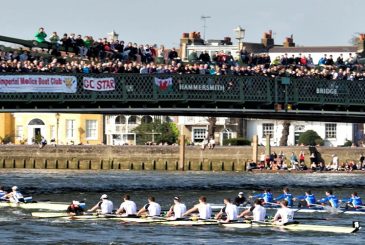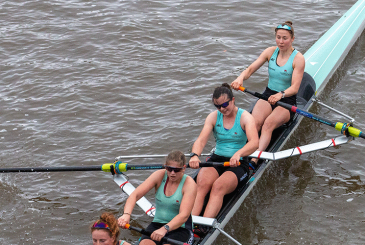Rachel Egan from JRN outlines her experience competing at one of the country’s most unique junior head races, and speaks to current juniors and coaches about their top tips for making the most of its unusual format.
The Oarsport Junior Sculling Head (OJSH) for quads and octs holds a particular place in my heart as the first national event I ever competed in. I’ll never forget the butterflies I felt that day approaching Dorney Lake. At J14, this journey seemed to go on forever, and it gave me plenty of time for my pre-race fears to set in. I completely lost any sense of appetite I was able to muster at 7am!
Looking back five years later, the lake definitely seems to be much smaller than the first time I saw it. Nevertheless, despite all the nerves that accompanied my OJSH debut, I reflect on my experiences there with pride, and I’m convinced that OJSH is a fantastic platform to compete against the best of the best in junior sculling.
Preparing for the unique format
The format of course is unconventional, comprising two relatively short runs of 1,800m on a 2,000m rowing lake with an un-timed turn in the middle, and other crews doing the same in 3 adjacent lanes. That said, I believe this format enables younger athletes to compete over a longer distance without being thrown in at the deep end too much, compared to a single 5km race, for example.
So, what can competitors do to prepare for this unique race configuration? Speaking to Josh Burrows, Junior Head Coach at Kingston RC, he advised competitors to, “Treat the race as two distinct pieces and, in doing so, take advantage of crews who have mismanaged pacing during the second piece.”
This sentiment was shared by Lily, currently at Headington School Oxford BC. She added, “In the lead up to OJSH, our crew typically completes two sets of 2k pieces with minimal rest in training, which allows us to adjust to the quick turnaround time during the event itself.”
It’s also worth planning what, if anything, you want to do differently on each run. For example, if it’s a windy day, you might want to focus on powerful finishes into a headwind, but quick catches and fast hands in a tailwind, and you may have slightly different target ratings for each one too.
Finally, with so many crews on the water, you’re unlikely to be able to get any kind of decent warm up in, so make sure you’ve done that on the land before you boat. The challenges of getting a vast number of crews boated and fitting into the marshalling lake also means that you must be ready to get hands on exactly when you’re called. There’s no time at that point for anyone to run back for a forgotten water bottle or coxbox, or to visit the portaloos again.

Staying focused
There’s never a shortage of top junior scullers at OJSH, with a lot hailing from programs who opt for sculling all season long. “As I coach at a club that predominantly focuses on sculling, OJSH is the pinnacle head race in the athletes’ calendars, and we focus on reaching peak endurance fitness for it,” Josh highlighted.
For those who also race the Schools’ Head, Josh emphasised the importance of athletes having to quickly reflect and apply their learnings from that to OJSH in a matter of days. “We race the Schools’ Head, get straight back into training the next day, and focus on rectifying anything that may not have gone to plan to iron out the creases before OJSH,” he explained. With this in mind, athletes who can self-evaluate quickly and respond to the necessary changes are best-placed to perform well at OJSH.
Maintaining composure as a crew will certainly help to reduce stress. Even if the first piece doesn’t go to plan, there’s still time for a few words of encouragement among the crew before an improved second piece. Josh agreed, “In reality, you need to take as long as you possibly can to turn around, so you can calm down a bit before the second piece, while still keeping the umpires happy.”
Usual head race advice applies
From my experience, the best advice I can offer is to stay calm. While this can be applied to all head races, the importance of composure at OJSH cannot be overstated. I personally found it really easy to panic between the piece. I even remember our crew trying to flaunt technical skill one year by tap-turning but this backfired and only added to my pre-race panic.
Don’t forget, either that as OJSH takes place at the end of March, the weather can easily be cold, wet and windy and you need to prepare for that. Lily has experienced this first-hand. She recalled, “Last year, it poured down with rain all day, so much so that they had to delay some of the divisions. A clean and dry set of kit for the bus ride home was much appreciated when I got off the water.”

Speaking of weather, even with the slightest wind, the open expanse of Dorney Lake becomes a battleground between gusts and blades. Top tip: practise sharp catches and remember it’s not the end of the world if you have to square your blades later than you might like!
In simple terms, go in with a plan, pace your race, and remain composed if things go array. Preparation is the best way to quell nerves and reassure yourself of your ability. This is a fantastic event made to be enjoyed. As long as you go out to race your best, you will champion the Oarsport Junior Sculling Head.










